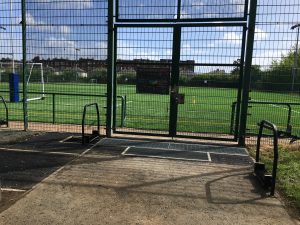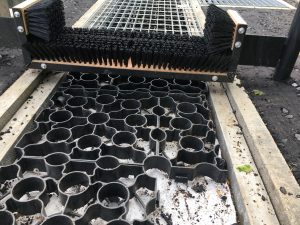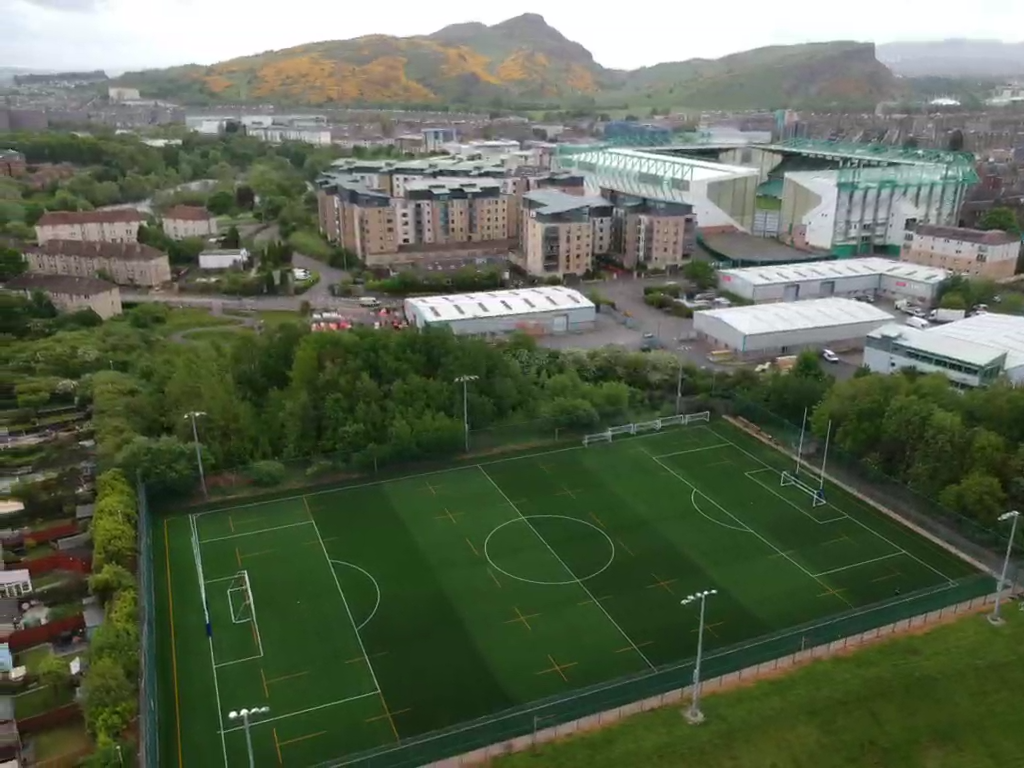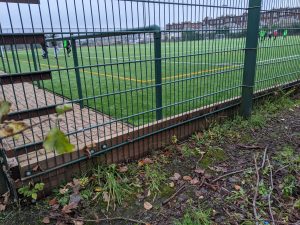When Leith Academy wanted to refurbish their artificial pitch used for football and rugby Sports Labs were contracted as the designers of the pitch and they felt it was important to mitigate against the potential for rubber infill material leaving the playing surface and reaching the surrounding environment. The mitigation implemented was low cost relative to the full project and incorporated kickboards, a detox area for players and fencing panels. We asked Fraser Gilbert, Project Engineer at Sports Labs to tell us more about the process:

Figure 1 The detox area at the main entrance (before kickboards installed)
Location: Leith Academy
Field type & use: 3G Synthetic Turf – Full-size football, rugby & 7-a-side football
Infill type: SBR Rubber
Infill mitigation measures: Kickboards & detox area inc. steel grate, removable geotextile lined trays, fencing panels to direct users through the area & boot brushes.
Approximate cost of mitigation measures: £8.5K
What were the reasons for including microplastic mitigation measures in this project?
The project consisted of a conversion from an existing 2G sand-dressed turf system to a new 3G turf system. The 3G turf system was required in order to accommodate football and rugby. The 3G turf system contains rubber infill which provides the performance characteristics enabling the pitch to perform at a level which meets the requirements of the FIFA Quality Programme – Handbook of Requirements (2015) and World Rugby Regulation 22 – Standard Relating to The Use of Rugby Turf. As the designer it was important to us to implement additional measures to mitigate against the potential for rubber infill material leaving the playing surface and reaching the surrounding environment.

Figure 2 Example of a detox area with removal grate beneath to facilitate reuse of any infill retrieved.
What approach was taken to reduce the loss of microplastic from this project?
As designer, the main consideration in this refurbishment project was mitigating against rubber infill migration. In order to do so, the following measures were put in place:
- Detox areas were installed at the main double entrance and at a newly installed single gate entrance.
- The detox area is set in concrete, with a geotextile lined tray placed in the ground (to allow drainage while capturing rubber infill from pitch users entering/ leaving the surface), covered by a removable steel grate. Boot brushes were installed above the grate for players to remove infill material when leaving the facility.
- Spectator panel fencing has also been installed at the main entrance to ensure pitch users are directed over the detox area.
- Timber kickboards were installed around the existing perimeter fence line to prevent infill material leaving the playing area.
The bespoke geotextile lined trays, recessed under the steel grates within the detox areas, are designed to capture infill leaving the facility. The trays shall be removed regularly by the maintenance teams and the collected performance infill put back into the pitch. Further to this, the pitch will undergo a standard good practice maintenance regime, including brushing treatment to provide an even distribution of infill over the pitch and prevent build up in certain areas, including pitch edges where they might pose greater risk of loss to the environment.

How are pitch users encouraged to help minimise infill loss?
The pitch is intended for use by a wide range of stakeholders and user groups including Leith Academy FC, Leith Academy RFC, Edinburgh Leisure and Leith Academy. It is hoped that the layout and design of the main access area shall encourage best practice to be implemented by pitch users where accessing and egressing the site to leave it in the same condition as it was found. For example, the new fencing system helps to ensure players use the boot brushes upon leaving – this keeps the area clean and tidy as well as reducing microplastic pollution. New Do’s & Don’ts signage instructing facility users how to use the detox areas was installed at the main access point to upgrade the existing damaged signs.

Figure 3 Kickboards
What were the biggest challenges to implementing mitigation measures?
As this was a refurbishment project, often design measures are fitted retrospectively to complement the existing facility. In this instance, a new single gate was required to be installed within the existing perimeter fencing system. This required removal of existing ball-stop panel fencing and replacement of fence posts. New kickboards were also installed to the existing perimeter fencing system. The new installed detox area required removal and extension of the existing grid and footpath as the existing area did not cover the full extent of the main access gate. As the designer, it was important to ensure these measures were considerate of the existing surrounding infrastructure.
How successful have the mitigation measures been? Are there any plans to monitor the infill loss?
The measures have been designed to prevent microplastic loss from occurring in the first place. Sports Labs intend to follow up with the school and other stakeholders, including local football and rugby clubs, to gather feedback as to the effectiveness of the measures. Any experience of best practice picked up in this regard shall be logged and this knowledge taken forward and implemented in future projects as we are always striving to improve in this area.
What advice would you give to someone looking to address the issue of microplastic infill loss from their 3G synthetic turf?
We have a responsibility as designers to ensure that the proposal considers fully the impacts of any materials we use. There is a drive in the industry towards finding new innovative solutions in this area and sharing best practice to develop new standards. We would recommend The Synthetic Turf Council as a good resource for designers looking to address microplastic infill loss by providing technical advice and guidance documents. There is also a latest release of the FIFA Quality Programme – Handbook of Test Methods (2015) amended to include microplastic mitigation measures. As Sports Labs Consultants we have the knowledge and experience of implementing these features within our specifications and design drawings for these facilities and are on hand to offer technical advice to clients.
About Sports Labs
Sports Labs are a professional services company. We are independent of all contractors, suppliers and manufacturers and operate a Consultancy Practice based out of our Livingston HQ. Sports Labs also offer an internationally accredited sports surface testing laboratory. We take pride in providing excellence in both sectors. The Consultancy team specialises in the design, procurement, tendering and project management of new or refurbished sports facilities such as artificial pitches and athletics tracks (Note here that Sports Labs Consult are acting as principal designer and contract administrator on the project. We do not manufacture, supply or install the synthetic turf system). Find out more on the Sports Labs website.
